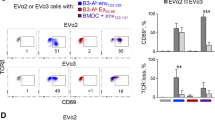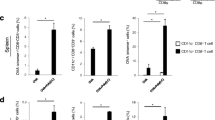Abstract
Immunization with adjuvant plus antigen induces durable T-cell immunity and is a mainstay of vaccines. Here, the consequence of separating antigen stimulation of T cells from the adjuvant response was studied in a re-transfer model. Effector CD8 T cells in recipient mice were exposed to lipopolysaccharide (LPS), the Toll-like receptor 4 (TLR4) ligand, which significantly increased persistence. While accumulation in lymphoid and non-lymphoid organs was evident, this result depended upon the timing of LPS administration and the presence of the TLR4 adaptor TRIF in the recipient mice. Interestingly, there was very little impact of the LPS response on subset differentiation, which rather appeared to be programmed by antigen and costimulation. To discern factors that limit accumulation, interleukin 10 (IL-10) was targeted since it is a product of TLR4 triggering and mitigates inflammation. Blockade of IL-10 increased accumulation even though the effector CD8 T cells were well past the priming phase, but upon recall interferon-γ secretion was not affected as would be expected when IL-10 is present during priming. Thus, the adjuvant-altered microenvironment is effective not only in the presence of antigen but also during a window of effector CD8 T-cell stasis, suggesting that pathogen-associated molecular pattern molecules released during co-infection, or by vaccines, could alter the survival fate of specific effector T cells.







Similar content being viewed by others
References
Pulendran B, Ahmed R . Translating innate immunity into immunological memory: implications for vaccine development. Cell 2006; 124: 849–863.
Sette A, Rappuoli R . Reverse vaccinology: developing vaccines in the era of genomics. Immunity 2010; 33: 530–541.
Grubaugh D, Flechtner JB, Higgins DE . Proteins as T cell antigens: methods for high-throughput identification. Vaccine 2013; 31: 3805–3810.
Curtsinger JM, Mescher MF . Inflammatory cytokines as a third signal for T cell activation. Curr Opin Immunol 2010; 22: 333–340.
Cui W, Joshi NS, Liu Y, Meng H, Kleinstein SH, Kaech SM . TLR4 ligands lipopolysaccharide and monophosphoryl lipid a differentially regulate effector and memory CD8+ T Cell differentiation. J Immunol 2014; 192: 4221–4232.
Maxwell JR, Rossi RJ, McSorley SJ, Vella AT . T cell clonal conditioning: a phase occurring early after antigen presentation but before clonal expansion is impacted by Toll-like receptor stimulation. J Immunol 2004; 172: 248–259.
Sawa Y, Arima Y, Ogura H, Kitabayashi C, Jiang JJ, Fukushima T et al. Hepatic interleukin-7 expression regulates T cell responses. Immunity 2009; 30: 447–457.
McKinstry KK, Strutt TM, Bautista B, Zhang W, Kuang Y, Cooper AM et al. Effector CD4 T-cell transition to memory requires late cognate interactions that induce autocrine IL-2. Nat Commun 2014; 5: 5377.
Starbeck-Miller GR, Xue HH, Harty JT . IL-12 and type I interferon prolong the division of activated CD8 T cells by maintaining high-affinity IL-2 signaling in vivo. J Exp Med 2014; 211: 105–120.
Marchingo JM, Kan A, Sutherland RM, Duffy KR, Wellard CJ, Belz GT et al. T cell signaling. Antigen affinity, costimulation, and cytokine inputs sum linearly to amplify T cell expansion. Science 2014; 346: 1123–1127.
Croft M . The role of TNF superfamily members in T-cell function and diseases. Nat Rev Immunol 2009; 9: 271–285.
Watts TH . TNF/TNFR family members in costimulation of T cell responses. Annu Rev Immunol 2005; 23: 23–68.
Croft M . The TNF family in T cell differentiation and function – unanswered questions and future directions. Semin Immunol 2014; 26: 183–190.
Mata-Haro V, Cekic C, Martin M, Chilton PM, Casella CR, Mitchell TC . The vaccine adjuvant monophosphoryl lipid A as a TRIF-biased agonist of TLR4. Science 2007; 316: 1628–1632.
Moran AE, Kovacsovics-Bankowski M, Weinberg AD . The TNFRs OX40, 4-1BB, and CD40 as targets for cancer immunotherapy. Curr Opin Immunol 2013; 25: 230–237.
Wortzman ME, Clouthier DL, McPherson AJ, Lin GH, Watts TH . The contextual role of TNFR family members in CD8(+) T-cell control of viral infections. Immunol Rev 2013; 255: 125–148.
Rahman AH, Taylor DK, Turka LA . The contribution of direct TLR signaling to T cell responses. Immunol Res 2009; 45: 25–36.
Fukata M, Breglio K, Chen A, Vamadevan AS, Goo T, Hsu D et al. The myeloid differentiation factor 88 (MyD88) is required for CD4+ T cell effector function in a murine model of inflammatory bowel disease. J Immunol 2008; 180: 1886–1894.
Tomita T, Kanai T, Fujii T, Nemoto Y, Okamoto R, Tsuchiya K et al. MyD88-dependent pathway in T cells directly modulates the expansion of colitogenic CD4+ T cells in chronic colitis. J Immunol 2008; 180: 5291–5299.
Cottalorda A, Verschelde C, Marcais A, Tomkowiak M, Musette P, Uematsu S et al. TLR2 engagement on CD8 T cells lowers the threshold for optimal antigen-induced T cell activation. Eur J Immunol 2006; 36: 1684–1693.
Gelman AE, Zhang J, Choi Y, Turka LA . Toll-like receptor ligands directly promote activated CD4+ T cell survival. J Immunol 2004; 172: 6065–6073.
Caramalho I, Lopes-Carvalho T, Ostler D, Zelenay S, Haury M, Demengeot J . Regulatory T cells selectively express toll-like receptors and are activated by lipopolysaccharide. J Exp Med 2003; 197: 403–411.
Rossi RJ, Muralimohan G, Maxwell JR, Vella AT . Staphylococcal enterotoxins condition cells of the innate immune system for Toll-like receptor 4 stimulation. Int Immunol 2004; 16: 1751–1760.
Gretz JE, Norbury CC, Anderson AO, Proudfoot AE, Shaw S . Lymph-borne chemokines and other low molecular weight molecules reach high endothelial venules via specialized conduits while a functional barrier limits access to the lymphocyte microenvironments in lymph node cortex. J Exp Med 2000; 192: 1425–1440.
Yadav R, Zammit DJ, Lefrancois L, Vella AT . Effects of LPS-mediated bystander activation in the innate immune system. J Leukoc Biol 2006; 80: 1251–1261.
Garcon N, Morel S, Didierlaurent A, Descamps D, Wettendorff M, Van Mechelen M . Development of an AS04-adjuvanted HPV vaccine with the adjuvant system approach. BioDrugs 2011; 25: 217–226.
Vella AT, McCormack JE, Linsley PS, Kappler JW, Marrack P . Lipopolysaccharide interferes with the induction of peripheral T cell death. Immunity 1995; 2: 261–270.
Maxwell JR, Weinberg A, Prell RA, Vella AT . Danger and OX40 receptor signaling synergize to enhance memory T cell survival by inhibiting peripheral deletion. J Immunol 2000; 164: 107–112.
Vella AT, Mitchell T, Groth B, Linsley PS, Green JM, Thompson CB et al. CD28 engagement and proinflammatory cytokines contribute to T cell expansion and long-term survival in vivo. J Immunol 1997; 158: 4714–4720.
Hacker H, Redecke V, Blagoev B, Kratchmarova I, Hsu LC, Wang GG et al. Specificity in Toll-like receptor signalling through distinct effector functions of TRAF3 and TRAF6. Nature 2006; 439: 204–207.
Myers L, Lee SW, Rossi RJ, Lefrancois L, Kwon BS, Mittler RS et al. Combined CD137 (4-1BB) and adjuvant therapy generates a developing pool of peptide-specific CD8 memory T cells. Int Immunol 2006; 18: 325–333.
Lee SJ, Rossi RJ, Lee SK, Croft M, Kwon BS, Mittler RS et al. CD134 Costimulation couples the CD137 pathway to induce production of supereffector CD8 T cells that become IL-7 dependent. J Immunol 2007; 179: 2203–2214.
Menoret A, McAleer JP, Ngoi SM, Ray S, Eddy NA, Fenteany G et al. The oxazolidinone derivative locostatin induces cytokine appeasement. J Immunol 2009; 183: 7489–7496.
Wright KT, Vella AT . RKIP contributes to IFN-gamma synthesis by CD8+ T cells after serial TCR triggering in systemic inflammatory response syndrome. J Immunol 2013; 191: 708–716.
Unkeless JC . Characterization of a monoclonal antibody directed against mouse macrophage and lymphocyte Fc receptors. J Exp Med 1979; 150: 580–596.
Reed SG, Orr MT, Fox CB . Key roles of adjuvants in modern vaccines. Nat Med 2013; 19: 1597–1608.
McAleer JP, Saris CJ, Vella AT . The WSX-1 pathway restrains intestinal T-cell immunity. Int Immunol 2011; 23: 129–137.
McAleer JP, Liu B, Li Z, Ngoi SM, Dai J, Oft M et al. Potent intestinal Th17 priming through peripheral lipopolysaccharide-based immunization. J Leukoc Biol 2010; 88: 21–31.
Ngoi SM, St Rose MC, Menoret AM, Smith DE, Tovey MG, Adler AJ et al. Presensitizing with a Toll-like receptor 3 ligand impairs CD8 T-cell effector differentiation and IL-33 responsiveness. Proc Natl Acad Sci USA 2012; 109: 10486–10491.
Ngoi SM, Tovey MG, Vella AT . Targeting poly(I:C) to the TLR3-independent pathway boosts effector CD8 T cell differentiation through IFN-alpha/beta. J Immunol 2008; 181: 7670–7680.
Strutt TM, McKinstry KK, Dibble JP, Winchell C, Kuang Y, Curtis JD et al. Memory CD4+ T cells induce innate responses independently of pathogen. Nat Med 2010; 16: 558–564, 551p following 564.
Takeda K, Akira S . TLR signaling pathways. Semin Immunol 2004; 16: 3–9.
McAleer JP, Rossi RJ, Vella AT . Lipopolysaccharide potentiates effector T cell accumulation into nonlymphoid tissues through TRIF. J Immunol 2009; 182: 5322–5330.
Yoshimura A, Mori H, Ohishi M, Aki D, Hanada T . Negative regulation of cytokine signaling influences inflammation. Curr Opin Immunol 2003; 15: 704–708.
Li MO, Flavell RA . Contextual regulation of inflammation: a duet by transforming growth factor-beta and interleukin-10. Immunity 2008; 28: 468–476.
Ahonen CL, Doxsee CL, McGurran SM, Riter TR, Wade WF, Barth RJ et al. Combined TLR and CD40 triggering induces potent CD8+ T cell expansion with variable dependence on type I IFN. J Exp Med 2004; 199: 775–784.
Flynn S, Toellner KM, Raykundalia C, Goodall M, Lane P . CD4 T cell cytokine differentiation: the B cell activation molecule, OX40 ligand, instructs CD4 T cells to express interleukin 4 and upregulates expression of the chemokine receptor, Blr-1. J Exp Med 1998; 188: 297–304.
Rogers PR, Croft M . CD28, Ox-40, LFA-1, and CD4 modulation of Th1/Th2 differentiation is directly dependent on the dose of antigen. J Immunol 2000; 164: 2955–2963.
McAleer JP, Zammit DJ, Lefrancois L, Rossi RJ, Vella AT . The lipopolysaccharide adjuvant effect on T cells relies on nonoverlapping contributions from the MyD88 pathway and CD11c+ cells. J Immunol 2007; 179: 6524–6535.
Yoshimura A, Muto G . TGF-beta function in immune suppression. Curr Top Microbiol Immunol 2011; 350: 127–147.
Olson BM, Sullivan JA, Burlingham WJ . Interleukin 35: a key mediator of suppression and the propagation of infectious tolerance. Front Immunol 2013; 4: 315.
Fiorentino DF, Zlotnik A, Vieira P, Mosmann TR, Howard M, Moore KW et al. IL-10 acts on the antigen-presenting cell to inhibit cytokine production by Th1 cells. J Immunol 1991; 146: 3444–3451.
O’Garra A, Barrat FJ, Castro AG, Vicari A, Hawrylowicz C . Strategies for use of IL-10 or its antagonists in human disease. Immunol Rev 2008; 223: 114–131.
Kondrack RM, Harbertson J, Tan JT, McBreen ME, Surh CD, Bradley LM . Interleukin 7 regulates the survival and generation of memory CD4 cells. J Exp Med 2003; 198: 1797–1806.
Acknowledgements
The authors would like to thank Drs. Adam Adler and Robert Clark for helpful discussions. Funding was provided by NIH/NIAID 2RO1 AI0142858-12A1 (Anthony T. Vella), and the research was developed by (Anthony T. Vella), while the studies were completed by (Wenhai Liu), and (Antoine Menoret) contributed key preliminary data on model development and assistance. The manuscript jointly written by (Anthony T. Vella) and (Wenhai Liu), and edited by (Antoine Menoret).
Author information
Authors and Affiliations
Corresponding author
Rights and permissions
About this article
Cite this article
Liu, W., Menoret, A. & Vella, A. Responses to LPS boost effector CD8 T-cell accumulation outside of signals 1 and 2. Cell Mol Immunol 14, 254–264 (2017). https://doi.org/10.1038/cmi.2015.69
Received:
Revised:
Accepted:
Published:
Issue Date:
DOI: https://doi.org/10.1038/cmi.2015.69
- Springer Nature Limited




